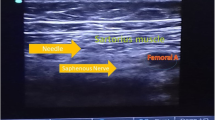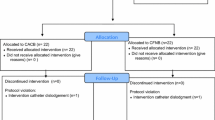Abstract
Purpose
Providing effective analgesia for total knee arthroplasty (TKA) patients remains challenging. Femoral nerve block (FNB) offers targeted pain control; however, its effect on motor function, related fall risk and impact on rehabilitation has been the source of controversy. Adductor canal block (ACB) potentially spares motor fibres of the femoral nerve, but the comparative effect of the two approaches has not yet been well defined due to considerable variability in pain perception. Our study compares both single-shot FNB and ACB, side to side, in the same patients undergoing bilateral TKA.
Methods
Sixty patients scheduled for bilateral TKA were randomised to receive ultrasound-guided FNB on one leg and ACB on the other, in addition to combined spinal epidural anaesthesia. The primary outcome was comparative postoperative pain in either extremity at six to eight, 24 and 48 hours postoperatively. Secondary comparative outcomes included motor strength (manually and via dynamometer), physical therapy milestones and patient satisfaction.
Results
While pain levels were lowest at six to eight hours postoperatively and increased thereafter (P < 0.001), no significant differences were seen between extremities at any time point with regard to pain in the quantitative comparison using visual analogue scale (VAS) scores (P = 0.4154), motor strength (P = 0.7548), physical therapy milestones or patient satisfaction. However, in the qualitative comparison, a significant proportion of patients reported the leg receiving ACB to be more painful than that receiving FNB at 24 h [50.9 % (n = 30) vs 25.42 % (n = 15), P = 0.0168)].
Conclusions
Although we could not confirm a benefit in motor function between ACB and FNB, given the equivalent analgesic potency combined with its potentially lower overall impact if neuropraxia should occur, ACB may represent an attractive alternative to FNB.

Similar content being viewed by others
References
Grosu I, Lavand'homme P, Thienpont E (2014) Pain after knee arthroplasty: an unresolved issue. Knee Surgery, Sports Traumatology, Arthroscopy. Off J ESSKA 22:1744–1758. doi:10.1007/s00167-013-2750-2
Kim MH, Nahm FS, Kim TK, Chang MJ, Do SH (2014) Comparison of postoperative pain in the first and second knee in staged bilateral total knee arthroplasty: clinical evidence of enhanced pain sensitivity after surgical injury. Pain 155:22–7. doi:10.1016/j.pain.2013.08.027
Petersen W, Rembitzki IV, Bruggemann GP, Ellermann A, Best R, Koppenburg AG, Liebau C (2014) Anterior knee pain after total knee arthroplasty: a narrative review. Int Orthop 38:319–28. doi:10.1007/s00264-013-2081-4
Paul JE, Arya A, Hurlburt L, Cheng J, Thabane L, Tidy A, Murthy Y (2010) Femoral nerve block improves analgesia outcomes after total knee arthroplasty: a meta-analysis of randomized controlled trials. Anesthesiology 113:1144–62. doi:10.1097/ALN.0b013e3181f4b18
Ilfeld BM, Mariano ER, Madison SJ et al (2011) Continuous femoral versus posterior lumbar plexus nerve blocks for analgesia after hip arthroplasty: a randomized, controlled study. Anesth Analg 113:897–903. doi:10.1213/ANE.0b013e318212495b
YaDeau JT, Cahill JB, Zawadsky MW (2005) The effects of femoral nerve blockade in conjunction with epidural analgesia after total knee arthroplasty. Anesth Analg 101:891–895, Table of contents
Broome CB, Burnikel B (2014) Novel strategies to improve early outcomes following total knee arthroplasty: a case control study of intra articular injection versus femoral nerve block. Int Orthop. doi:10.1007/s00264-014-2392-0
Kandasami M, Kinninmonth AW, Sarungi M, Baines J, Scott NB (2009) Femoral nerve block for total knee replacement - a word of caution. Knee 16:98–100. doi:10.1016/j.knee.2008.10.007
Sharma S, Iorio R, Specht LM, Davies-Lepie S, Healy WL (2010) Complications of femoral nerve block for total knee arthroplasty. Clin Orthop Relat Res 468:135–40. doi:10.1007/s11999-009-1025-1
Wasserstein D, Farlinger C, Brull R, Mahomed N, Gandhi R (2013) Advanced age, obesity and continuous femoral nerve blockade are independent risk factors for inpatient falls after primary total knee arthroplasty. J Arthroplast 28:1121–4. doi:10.1016/j.arth.2012.08.018
Horn JL, Pitsch T, Salinas F, Benninger B (2009) Anatomic basis to the ultrasound-guided approach for saphenous nerve blockade. Reg Anesth Pain Med 34:486–489. doi:10.1097/AAP.0b013e3181ae11af
Manickam B, Perlas A, Duggan E, Brull R, Chan VW, Ramlogan R (2009) Feasibility and efficacy of ultrasound-guided block of the saphenous nerve in the adductor canal. Reg Anesth Pain Med 34:578–80
Jaeger P, Grevstad U, Henningsen MH, Gottschau B, Mathiesen O, Dahl JB (2012) Effect of adductor-canal-blockade on established, severe post-operative pain after total knee arthroplasty: a randomised study. Acta Anaesthesiol Scand 56:1013–9. doi:10.1111/j.1399-6576.2012.02737.x
Andersen HL, Gyrn J, Moller L, Christensen B, Zaric D (2013) Continuous saphenous nerve block as supplement to single-dose local infiltration analgesia for postoperative pain management after total knee arthroplasty. Reg Anesth Pain Med 38:106–11. doi:10.1097/AAP.0b013e31827900a9
Jaeger P, Nielsen ZJ, Henningsen MH, Hilsted KL, Mathiesen O, Dahl JB (2013) Adductor canal block versus femoral nerve block and quadriceps strength: a randomized, double-blind, placebo-controlled, crossover study in healthy volunteers. Anesthesiology 118:409–15. doi:10.1097/ALN.0b013e318279fa0b
DeLoach LJ, Higgins MS, Caplan AB, Stiff JL (1998) The visual analog scale in the immediate postoperative period: intrasubject variability and correlation with a numeric scale. Anesth Analg 86:102–6
Gerbershagen HJ, Rothaug J, Kalkman CJ, Meissner W (2011) Determination of moderate-to-severe postoperative pain on the numeric rating scale: a cut-off point analysis applying four different methods. Br J Anaesth 107:619–26. doi:10.1093/bja/aer195
Urban MK, Chisholm M, Wukovits B (2006) Are postoperative complications more common with single-stage bilateral (SBTKR) than with unilateral knee arthroplasty: guidelines for patients scheduled for SBTKR. HSS Journal. Musculoskelet J Hos Special Surg 2:78–82. doi:10.1007/s11420-005-0125-z
Memtsoudis SG, Hargett M, Russell LA et al (2013) Consensus statement from the consensus conference on bilateral total knee arthroplasty group. Clin Orthop Relat Res 471:2649–57. doi:10.1007/s11999-013-2976-9
Sapega AA (1990) Muscle performance evaluation in orthopaedic practice. J Bone Joint Surg 72:1562–1574, American Volume
Szucs S, Iohom G, O'Donnell B, Sajgalik P, Ahmad I, Salah N, Shorten G. (2012) Analgesic efficacy of continuous femoral nerve block commenced prior to operative fixation of fractured neck of femur. Perioperative Medicine (London, England) 1: 4,0525-1-4. eCollection 2012. doi: 10.1186/2047-0525-1-4
Gordon DB, Stevenson KK, Griffie J, Muchka S, Rapp C, Ford-Roberts K (1999) Opioid equianalgesic calculations. J Palliat Med 2:209–18. doi:10.1089/jpm.1999.2.209
Amabile CM, Bowman BJ (2006) Overview of oral modified-release opioid products for the management of chronic pain. Ann Pharmacother 40:1327–1335
Liu S, Carpenter RL, Mulroy MF, Weissman RM, McGill TJ, Rupp SM, Allen HW (1995) Intravenous versus epidural administration of hydromorphone. Effects on analgesia and recovery after radical retropubic prostatectomy. Anesthesiol 82:682–688
Harris PA, Taylor R, Thielke R, Payne J, Gonzalez N, Conde JG (2009) Research electronic data capture (REDCap)–a metadata-driven methodology and workflow process for providing translational research informatics support. J Biomed Inform 42:377–81. doi:10.1016/j.jbi.2008.08.010
Ma Y, Mazumdar M, Memtsoudis SG (2012) Beyond repeated-measures analysis of variance: advanced statistical methods for the analysis of longitudinal data in anesthesia research. Reg AnesthPain Med 37:99–105. doi:10.1097/AAP.0b013e31823ebc74
Schulz KF, Altman DG, Moher D, CONSORT Group (2010) CONSORT 2010 statement: updated guidelines for reporting parallel group randomized trials. Ann Intern Med 152:726–32. doi:10.7326/0003-4819-152-11-201006010-00232
Hsu LP, Oh S, Nuber GW, Jr Doty R, Kendall MC, Gryzlo S, Nader A (2013) Nerve block of the infrapatellar branch of the saphenous nerve in knee arthroscopy: a prospective, double-blinded, randomized, placebo-controlled trial. J Bone Joint Surg 95:1465–1472. doi:10.2106/JBJS.L.01534, American Volume
Ishiguro S, Asano N, Yoshida K et al (2013) Day zero ambulation under modified femoral nerve block after minimally invasive surgery for total knee arthroplasty: preliminary report. J Anesth 27:132–4. doi:10.1007/s00540-012-1479-2
Kim DH, Lin Y, Goytizolo EA et al (2014) Adductor canal block versus femoral nerve block for total knee arthroplasty: a prospective, randomized, controlled trial. Anesthesiology 120:540–50. doi:10.1097/ALN.0000000000000119
Memtsoudis SG, Ma Y, Gonzalez Della Valle A, Mazumdar M, Gaber-Baylis LK, MacKenzie CR, Sculco TP (2009) Perioperative outcomes after unilateral and bilateral total knee arthroplasty. Anesthesiology 111:1206–16. doi:10.1097/ALN.0b013e3181bfab7d
Acknowledgments
We thank Isabelle Kao and Heather Reel for assisting with data collection and management.
Funding
This study was performed with funds from the Hospital for Special Surgery, Department of Anesthesiology, New York, NY, USA, and the Anna-Maria and Stephen Kellen Physician-Scientist Career Development Award, New York, NY, USA (Stavros G. Memtsoudis). Research was supported in part by the Clinical and Translational Science Center (CTSC) at Weill Cornell Medical College through grant no. UL1TR000457-06. Contribution of Dr. Ma on this project was supported in part by the Agency for Healthcare and Quality Research (AHRQ, Rockville, MD) grant no. R01HS021734. The content is solely the responsibility of the authors and does not necessarily represent the official views of the funding source, AHRQ, based in Rockville, MD, USA.
Conflicts of interest
None.
Author information
Authors and Affiliations
Corresponding author
Rights and permissions
About this article
Cite this article
Memtsoudis, S.G., Yoo, D., Stundner, O. et al. Subsartorial adductor canal vs femoral nerve block for analgesia after total knee replacement. International Orthopaedics (SICOT) 39, 673–680 (2015). https://doi.org/10.1007/s00264-014-2527-3
Received:
Accepted:
Published:
Issue Date:
DOI: https://doi.org/10.1007/s00264-014-2527-3




